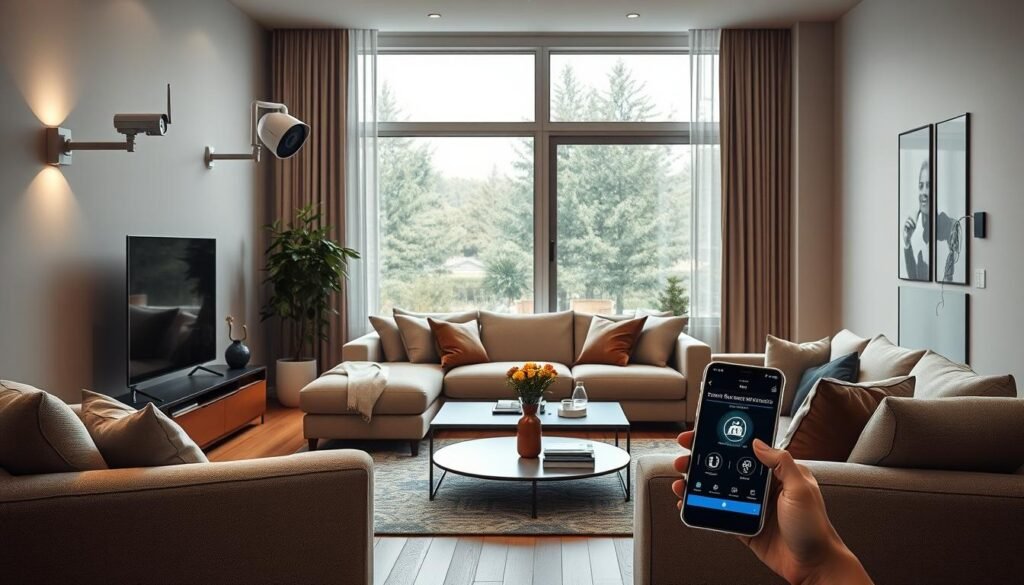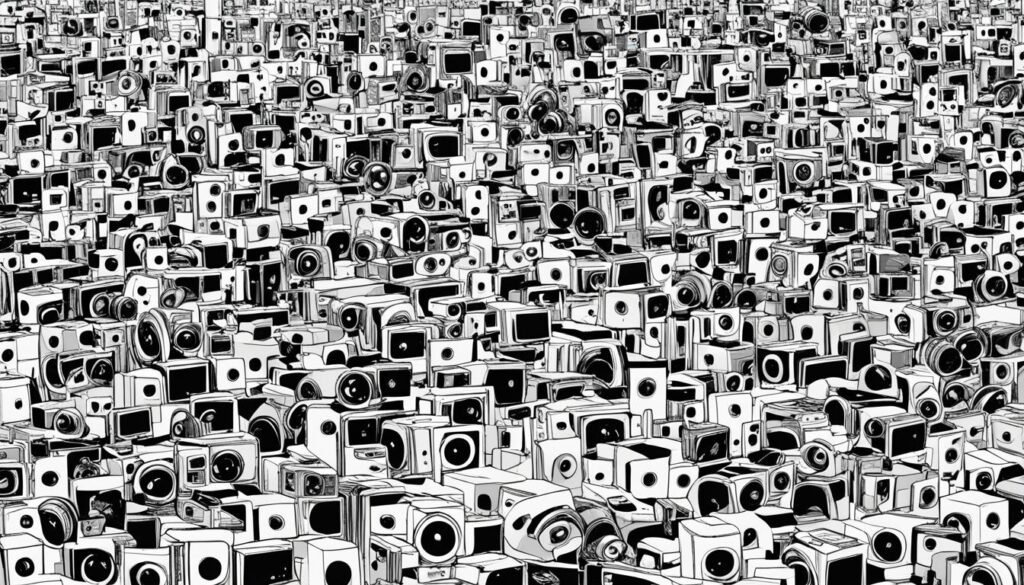Is your home safe in today’s digital world? Smart home security systems are changing how we keep our homes safe. They bring peace of mind with connected devices and remote monitoring.
Forget old-school locks and alarms. Now, smart home security combines cameras, sensors, and smart locks into one system. Homeowners can watch over their property from anywhere with smartphones or tablets.
Smart home security is super convenient. Imagine looking at your front door camera while at work or changing your thermostat from the store. These systems protect and automate your home, making life easier and more efficient.
We’ll dive into smart home security’s parts, perks, and how it’s changing home safety. Get ready to see how these systems can make your home safe and connected.
Understanding Smart Home Security: The Basics
Smart home security systems are changing how we keep our homes safe. They mix new technology with old security methods for a safer place to live.
What is a smart home security system?
A smart home security system connects different devices to protect your property. It uses IoT security to share information and give updates in real-time to homeowners.
Components of a smart home security setup
Important parts of these systems are security cameras, smart locks, and motion sensors. Some also have doorbell cameras and devices that check the environment. These parts work well with other smart devices for a full security solution.
Benefits of smart home security
Smart security systems have many benefits. They send alerts in real-time, so you can act fast if needed. You can check on your home from anywhere with remote access. According to industry data, 85% of homeowners feel safer after getting a smart system. These systems also work with other smart devices, making your home more efficient and convenient.
DIY vs. Professional Installation: Choosing the Right Approach
Homeowners have a big decision when setting up a smart home security system. They must choose between DIY security systems and professional installation. Each option has its own benefits, depending on several factors.
DIY security systems are great for those who love tech and enjoy doing things themselves. Brands like SimpliSafe and Ring Alarm let users set up their own systems. This can save money on installation costs. However, 45% of DIY setups face technical problems.
Professional installation services, offered by companies like ADT and Vivint, provide expert setup. These services cost more, between $100 to $200, but have a 97% success rate. This is a good choice for those who want ease and reliability, with 60% choosing this path.
Customers are happier with professional installations. 70% of those who go this route are more satisfied with their systems. Professional setups also have fewer false alarms, about 10%, compared to 30% for DIY.
The choice between DIY and professional installation depends on your skills, budget, and how sure you want to be. Think about how comfortable you are with technology and the complexity of your system before deciding.
Key Features of Modern Smart Home Security Systems
Smart home security systems have grown to include advanced features. They mix the latest technology with easy-to-use interfaces. This makes living safer and more convenient.
Video Surveillance and Doorbell Cameras
High-resolution cameras give you clear views of your property. Smart doorbells with two-way audio let you talk to visitors from anywhere. Some systems use AI to recognize faces, adding more security.
Smart Locks and Access Control
Keyless entry lets you lock and unlock doors from anywhere. You can give temporary access to guests or service people without giving them keys. This is great for families with kids, as 65% of such families use smart home security.
Motion Sensors and Alarms
Motion sensors catch unauthorized entry and set off alarms. They work with smart lighting to scare off intruders. Homeowners see a 40% drop in break-ins after getting smart security systems.
Environmental Monitoring
These systems have sensors for fire, carbon monoxide, and water leaks. They alert you to dangers early. Many can be controlled with voice commands.
With these features, smart home security systems offer full protection. They protect against intruders and environmental dangers. This makes homes safer and more efficient.
Integration with Smart Home Ecosystems
Smart home integration is changing how we keep our homes safe and manage them. It connects security systems with platforms like Amazon Alexa, Google Home, and Apple HomeKit. This lets users control their security devices with voice assistants, making life easier and more efficient.
The voice recognition market was worth $9.74 billion in 2023 and is growing fast, at 14.87% a year until 2033. This shows how popular voice-controlled smart home systems are getting. Companies like Microsoft, Google, Apple, and Amazon are leading this change, making their voice assistants better all the time.
With smart home integration, you can turn on your security system, lock doors, and change lights with just your voice. This makes life easier and safer. For instance, Home Assistant lets users control all their lights and HVAC systems with one interface.
The future of smart home security is bright, thanks to AI and IoT tech. As these systems get more connected, homeowners will enjoy a safer, more efficient, and truly smart home life.
Smart Home Security: Cost Considerations and Budgeting
Planning a smart home security system means understanding the costs. Prices vary a lot based on the equipment, installation, and monitoring you choose.
Initial Equipment Costs
Basic smart home security systems start at $150 to $300. They usually include a control panel, a few sensors for doors and windows, and motion detectors. For a full system with cameras, smart locks, and environmental sensors, costs can go over $1,000.
Installation Fees
Professional installation costs about $200. If you’re good with tools, you can save money by doing it yourself. Many companies offer easy-to-use equipment for DIY installation.
Monthly Monitoring Expenses
Monitoring fees are between $15 to $60 a month. The cost depends on the service level and features you want. Self-monitoring through an app is often free but means you have to handle alerts yourself. Professional monitoring offers 24/7 support and can call emergency services if needed.
To cut costs, look for refurbished equipment or bundled deals. Some companies let you create a custom package. This way, you only pay for what you need. By thinking about your security needs and budget, you can find a smart home security solution that’s both affordable and effective.
Advanced AI and IoT Technologies in Home Security
The world of home security is changing fast. Artificial intelligence and the Internet of Things are making our homes safer than ever. These smart systems can tell the difference between a person and a pet, cutting down on false alarms. They work faster and keep your information private.
IoT devices connect all parts of your security system. They link cameras, locks, and sensors. This makes everything work together smoothly. AI helps these systems learn and get better over time. They can spot unusual events and act quickly to keep you safe.
The market for these smart security devices is growing fast. By 2032, it could be worth over $370 billion. This growth shows how much people trust and want these new technologies. With cyber attacks on the rise, these advanced systems are more important than ever.
AI and IoT are not just making homes safer. They’re also changing how we live. Smart cameras can now see in 3D, giving a clearer picture of what’s happening. In the US alone, there are 30 million security cameras in use. This network of smart devices is making our cities safer and more efficient.
Monitoring Options: Self-Monitoring vs. Professional Services
Smart home security systems have different monitoring choices for various needs and budgets. Let’s look at the options available to homeowners.
Self-Monitoring: Control at Your Fingertips
Self-monitoring lets you take charge of your home’s security. You get security alerts on your smartphone, so you can check in anytime. This choice gives you control and can save money on monthly fees. But, it requires constant vigilance and quick action from you.
Professional Monitoring: Round-the-Clock Protection
Professional services offer 24/7 monitoring by trained experts. They handle emergencies and send help when needed. This option gives peace of mind but has higher monthly costs. Prices usually range from $20 to $60 per month, depending on the system and features.
Hybrid Solutions: The Best of Both Worlds
Some companies now offer hybrid monitoring options. These let you switch between self-monitoring and professional services as needed. This flexibility can be useful for vacations or times when you can’t monitor your system yourself.
Choosing the right monitoring option depends on your lifestyle, budget, and security needs. Think about each option carefully to find the best fit for your smart home security system.
Enhancing Property Value Through Smart Home Security
Smart home security systems are changing the game in real estate. They protect homes and increase property value. Studies show homes with smart security sell for 3-5% more.
Real estate security is more than just locks and alarms now. It includes video doorbells, smart locks, and AI cameras. These features make homes more appealing to buyers who value safety.
Homeowners gain a lot from smart security. Insurance companies offer discounts for homes with these features. This leads to long-term savings, adding to the property’s value.
Properties with smart security systems sell faster. Buyers pay more for homes that offer peace of mind and the latest technology. This means sellers can ask for higher prices for their tech-savvy homes.
The effect of smart security on property value will keep growing. As technology gets cheaper and better, these systems will become common in homes. Early investors in this trend may see even bigger returns later on.
Privacy and Data Security Concerns in Smart Home Systems
Smart home security systems make life easier but also raise concerns about privacy and cybersecurity. They collect sensitive information, so it’s important to know how companies use your data. A recent survey showed that 65% of smart home users worry about their personal info being at risk.
To keep your data safe, pick trusted providers with strong security measures. Look for companies that use encryption and have clear privacy policies. Some users have faced issues with device connectivity and strange behaviors. For instance, one user’s Nest Mini played odd sounds even after a reset, showing possible security issues.
Keeping your home network secure is key. Use strong, unique passwords for all devices and turn on two-factor authentication if it’s available. Also, update your devices regularly to fix security holes. A study found that 30% of smart home users don’t update their systems, leaving them open to cyber threats.
Think about what data you share. Some devices gather more info than they need. Check your privacy settings and turn off features you don’t use. Your smart home security system should keep you safe without invading your privacy.
Future Trends in Smart Home Security Technology
The smart home security world is changing fast, with new technologies leading the way. The Video Surveillance Market is growing quickly, with a 12.98% CAGR from 2023 to 2033. This means we’ll see more smart home innovations that make our homes safer and more convenient.
Artificial Intelligence (AI) and machine learning are key to these changes. They’re making threat detection better and cutting down on false alarms. This makes security systems more dependable. With 5G networks, devices will connect faster and more reliably, improving how well everything works together.
Biometric authentication, like facial recognition and fingerprint scanning, is becoming more common in smart home security. This matches the growth of companies like Hikvision and Dahua, big names in video surveillance. Their new tech, along with Axis Communications’ IP cameras, is pushing the industry ahead.
The LED Lighting Market is worth $75.65 billion in 2023 and is still growing. We’ll see more smart lighting and security systems working together. This will lead to better, more energy-saving home protection solutions. It’s a step towards combining security with smart home convenience in exciting new ways.


